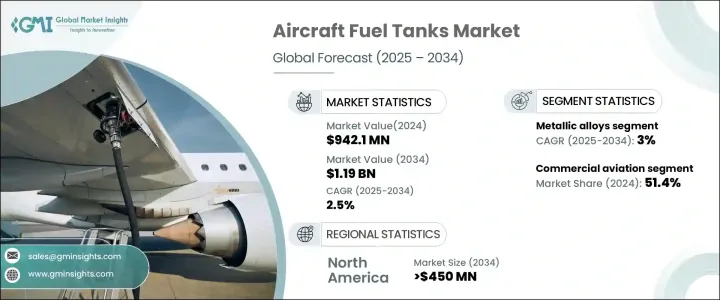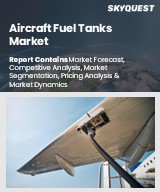
|
시장보고서
상품코드
1684629
항공기 연료 탱크 시장 기회, 성장 촉진 요인, 산업 동향 분석, 예측(2025-2034년)Aircraft Fuel Tanks Market Opportunity, Growth Drivers, Industry Trend Analysis, and Forecast 2025 - 2034 |
||||||
항공기 연료 탱크 세계 시장은 2024년 9억 4,210만 달러로 평가되었고, 2025년부터 2034년까지 연평균 복합 성장률(CAGR) 2.5%로 성장할 것으로 예측됩니다. 이러한 성장의 원동력이 되고 있는 것은 항공업계가 연료 효율 향상과 운항 비용 절감에 점점 주력하고 있다는 점입니다. 항공사와 군사 사업자는 항공기의 성능을 최적화하기 위해 경량 연료 탱크 솔루션을 선호합니다. 연료 탱크의 경량화는 항공기 전체의 무게를 크게 줄이고 연료 효율 향상, 비행 거리 연장, 이산화탄소 배출량 감소에 직결합니다.

또한 지속가능성 추진과 보다 엄격한 환경규제 대응도 첨단 연료탱크 기술에 대한 수요를 지속적으로 추진하고 있습니다. 복합재료와 엔지니어링 기법의 혁신으로 경량화 뿐만 아니라 강도, 내구성, 내식성, 내미생물 오염성을 갖춘 탱크의 개발이 가능해지고 있습니다. 항공업계가 운항효율의 향상과 환경부하의 저감에 노력하고 있는 가운데, 고성능이고 경량인 연료탱크 시스템에 대한 수요가 높아져 항공기 설계의 미래가 형성될 것으로 예상됩니다.
| 시장 범위 | |
|---|---|
| 시작연도 | 2024 |
| 예측연도 | 2025-2034 |
| 시작금액 | 9억 4,210만 달러 |
| 예측 금액 | 11억 9,000만 달러 |
| CAGR | 2.5% |
항공기 연료 탱크 시장은 주로 플랫폼별로 구분되며, 민간항공, 군사항공 및 기타 카테고리가 주요 부문을 구성하고 있습니다. 2024년에는 민간항공이 51.4%로 가장 큰 시장 점유율을 차지하고 연료 효율이 높고 환경에 적합한 연료 탱크 솔루션에 대한 요구가 높아지는 것이 요인이 되었습니다. 항공사는 성능을 극대화하면서 운항 비용을 절감하는 방법을 모색하고 있어 경량으로 연료 저장을 최적화할 수 있는 연료 탱크 시스템 수요가 급증하고 있습니다. 항공기 제조업체는 이러한 요구 사항을 충족하고 환경 기준을 준수하기 위해 연료 탱크 설계에 고급 복합재료를 도입하기 위해 노력하고 있습니다.
또 다른 중요한 시장 내역은 재료의 유형이며 탄소계 복합재료, 금속 합금, 하이브리드 재료, 폴리머가 포함됩니다. 이 중 금속 합금 부문은 예측 기간 동안 CAGR 3%로 확대될 것으로 예상됩니다. 특히 알루미늄 합금은 강도, 경량 특성, 비용 효율성을 결합하여 항공기 연료 탱크 제조에 널리 사용됩니다. 알루미늄은 내식성이 뛰어나 제조가 용이하기 때문에 민간 항공기의 제조, 특히 신뢰성과 내구성이 높은 연료 탱크 시스템을 필요로 하는 대형 항공기에 바람직하게 사용되고 있습니다.
지역별 성장이라는 점에서 북미 항공기 연료 탱크 시장은 2034년까지 4억 5,000만 달러를 창출할 것으로 예측됩니다. 이 시장 확대는 민간항공부문과 군용항공부문 모두에 대한 수요에 따른 점이 큽니다. 이 성장의 주요 요인으로는 항공기 확대, 기술 발전, 군사 조달 등이 있습니다. 또한 경량 소재의 혁신, 연료 효율 개선, 안전성 및 지속가능성에 대한 규제 강화가 시장을 더욱 형성하여 연료 탱크 기술과 생산의 지속적인 발전을 촉진하고 있습니다. 북미의 고성능, 친환경 연료 탱크 솔루션에 대한 요구는 지속적으로 높아 향후 수년간 견고한 성장이 예상됩니다.
목차
제1장 조사 방법과 조사 범위
- 시장 범위와 정의
- 기본 추정과 계산
- 예측 계산
- 데이터 소스
- 1차 데이터
- 2차 데이터
- 유료 정보원
- 공적 정보원
제2장 주요 요약
제3장 업계 인사이트
- 생태계 분석
- 밸류체인에 영향을 주는 요인
- 이익률 분석
- 파괴
- 장래의 전망
- 제조업체
- 유통업체
- 공급자의 상황
- 이익률 분석
- 주요 뉴스
- 규제 상황
- 영향요인
- 성장 촉진요인
- 항공기용 연료 탱크의 경량화 솔루션에 대한 수요 증가
- 상용 및 방위용도에서의 UAV 채용 증가
- 연료 탱크용 복합재료의 기술 진보
- 여객 수송량 증가에 의한 항공기 생산율의 향상
- 항공연료 효율 및 배출에 관한 엄격한 규제
- 업계의 잠재적 위험 및 과제
- 첨단 항공기용 연료 탱크 기술에 따른 고비용
- 복합재 연료 탱크의 리사이클과 폐기에 있어서의 과제
- 성장 촉진요인
- 성장 가능성 분석
- Porter's Five Forces 분석
- PESTEL 분석
제4장 경쟁 구도
- 소개
- 기업 점유율 분석
- 경쟁 포지셔닝 매트릭스
- 전략 전망 매트릭스
제5장 시장 추정 및 예측 : 유형별, 2021년-2034년
- 주요 동향
- 외부 탱크
- 컨포멀 탱크
- 드롭 탱크
- 내부 탱크
- 일체형 탱크
- 리지드 리무버블 탱크
- 브라더 탱크
- 칩 탱크
- 보조 탱크
제6장 시장 추정 및 예측 : 플랫폼별, 2021년-2034년
- 주요 동향
- 민간 항공기
- 민간 항공기
- 일반 및 비즈니스 항공기
- 헬리콥터
- 군용기
- 고정익기
- 헬리콥터
- 무인 항공기(UAV)
- 기타
제7장 시장 추정 및 예측 : 소재별, 2021년-2034년
- 주요 동향
- 탄소계 복합재료
- 금속 합금
- 하이브리드
- 폴리머
제8장 시장 추정 및 예측 : 최종 용도별, 2021년-2034년
- 주요 동향
- 애프터마켓
- 부품 교환
- MRO
- OEM 시장
제9장 시장 추정 및 예측 : 지역별, 2021년-2034년
- 주요 동향
- 북미
- 미국
- 캐나다
- 유럽
- 영국
- 독일
- 프랑스
- 이탈리아
- 스페인
- 러시아
- 아시아태평양
- 중국
- 인도
- 일본
- 한국
- 호주
- 라틴아메리카
- 브라질
- 멕시코
- 중동 및 아프리카
- 남아프리카
- 사우디아라비아
- 아랍에미리트(UAE)
제10장 기업 프로파일
- Aerospace Fuel Systems Inc.
- Collins Aerospace(Raytheon Technologies)
- Eaton Corporation
- Elbit Systems – Cyclone Ltd.
- General Dynamics Corporation
- GKN Aerospace
- Honeywell International Inc.
- Lockheed Martin Corporation
- Marshall Aerospace and Defence Group
- Meggitt PLC
- Northstar
- Parker Hannifin Corporation
- Robertson Fuel Systems LLC
- Safran SA
The Global Aircraft Fuel Tanks Market, valued at USD 942.1 million in 2024, is expected to grow at a CAGR of 2.5% from 2025 to 2034. This growth is fueled by the aviation sector's increasing focus on enhancing fuel efficiency and reducing operational costs. Airlines and military operators are prioritizing lightweight fuel tank solutions to optimize aircraft performance. Lighter fuel tanks significantly reduce overall aircraft weight, which directly leads to improved fuel efficiency, extended flight range, and lower carbon emissions.

The push for sustainability and compliance with stricter environmental regulations also continues to drive demand for advanced fuel tank technologies. Innovations in composite materials and engineering methods are enabling the development of tanks that are not only lighter but also stronger, more durable, and resistant to corrosion and microbial contamination. As the aviation industry strives for greater operational efficiency and lower environmental impact, the demand for high-performance, lightweight fuel tank systems is expected to rise, shaping the future of aircraft design.
| Market Scope | |
|---|---|
| Start Year | 2024 |
| Forecast Year | 2025-2034 |
| Start Value | $942.1 Million |
| Forecast Value | $1.19 Billion |
| CAGR | 2.5% |
The aircraft fuel tanks market is primarily segmented by platform, with commercial aviation, military aviation, and other categories making up the key divisions. In 2024, commercial aviation held the largest market share at 51.4%, driven by the growing need for fuel-efficient and environmentally compliant fuel tank solutions. Airlines are seeking ways to reduce operational costs while maximizing performance, which has led to a surge in demand for fuel tank systems that are both lightweight and capable of optimizing fuel storage. Aircraft manufacturers are increasingly incorporating advanced composite materials into their fuel tank designs to meet these requirements and adhere to environmental standards.
Another important market segment is material type, which includes carbon-based composites, metallic alloys, hybrid materials, and polymers. Among these, the metallic alloys segment is expected to expand at a CAGR of 3% during the forecast period. Aluminum alloys, in particular, are widely used in the production of aircraft fuel tanks due to their combination of strength, lightweight characteristics, and cost-effectiveness. Aluminum's resistance to corrosion and ease of manufacturing makes it a preferred choice for commercial aircraft production, especially in large fleets that require reliable and durable fuel tank systems.
In terms of regional growth, the North America aircraft fuel tanks market is projected to generate USD 450 million by 2034. This market expansion is largely driven by demand across both the commercial and military aviation sectors. Key factors contributing to this growth include fleet expansion, technological progress, and military procurement. Moreover, innovations in lightweight materials, improved fuel efficiency, and stricter safety and sustainability regulations further shape the market, driving continued progress in fuel tank technology and production. The need for high-performance, environmentally friendly fuel tank solutions in North America is expected to remain strong, ensuring robust growth in the coming years.
Table of Contents
Chapter 1 Methodology & Scope
- 1.1 Market scope & definitions
- 1.2 Base estimates & calculations
- 1.3 Forecast calculations
- 1.4 Data sources
- 1.4.1 Primary
- 1.4.2 Secondary
- 1.4.2.1 Paid sources
- 1.4.2.2 Public sources
Chapter 2 Executive Summary
- 2.1 Industry synopsis, 2021-2034
Chapter 3 Industry Insights
- 3.1 Industry ecosystem analysis
- 3.1.1 Factor affecting the value chain
- 3.1.2 Profit margin analysis
- 3.1.3 Disruptions
- 3.1.4 Future outlook
- 3.1.5 Manufacturers
- 3.1.6 Distributors
- 3.2 Supplier landscape
- 3.3 Profit margin analysis
- 3.4 Key news & initiatives
- 3.5 Regulatory landscape
- 3.6 Impact forces
- 3.6.1 Growth drivers
- 3.6.1.1 Increasing demand for lightweight aircraft fuel tank solutions
- 3.6.1.2 Rising adoption of UAVs in commercial and defense applications
- 3.6.1.3 Technological advancements in composite materials for fuel tanks
- 3.6.1.4 Growing air passenger traffic boosting aircraft production rates
- 3.6.1.5 Stringent regulations on aviation fuel efficiency and emissions
- 3.6.2 Industry pitfalls & challenges
- 3.6.2.1 High costs associated with advanced aircraft fuel tank technologies
- 3.6.2.2 Challenges in recycling and disposal of composite fuel tanks
- 3.6.1 Growth drivers
- 3.7 Growth potential analysis
- 3.8 Porter's analysis
- 3.9 PESTEL analysis
Chapter 4 Competitive Landscape, 2024
- 4.1 Introduction
- 4.2 Company market share analysis
- 4.3 Competitive positioning matrix
- 4.4 Strategic outlook matrix
Chapter 5 Market Estimates & Forecast, By Type, 2021-2034 (USD Million)
- 5.1 Key trends
- 5.2 External
- 5.2.1 Conformal tanks
- 5.2.2 Drop tanks
- 5.3 Internal
- 5.3.1 Integral tanks
- 5.3.2 Rigid removable tanks
- 5.3.3 Bladder tanks
- 5.3.4 Tip tanks
- 5.3.5 Auxiliary tanks
Chapter 6 Market Estimates & Forecast, By Platform, 2021-2034 (USD Million)
- 6.1 Key trends
- 6.2 Commercial aviation
- 6.2.1 Commercial aircraft
- 6.2.2 General & Business aircraft
- 6.2.3 Helicopters
- 6.3 Military aviation
- 6.3.1 Fixed-wing aircraft
- 6.3.2 Helicopters
- 6.3.3 Unmanned Aerial Vehicles (UAVs)
- 6.4 Others
Chapter 7 Market Estimates & Forecast, By Material, 2021-2034 (USD Million)
- 7.1 Key trends
- 7.2 Carbon-based composites
- 7.3 Metallic alloys
- 7.4 Hybrid
- 7.5 Polymers
Chapter 8 Market Estimates & Forecast, By End Use, 2021-2034 (USD Million)
- 8.1 Key trends
- 8.2 Aftermarket
- 8.2.1 Parts replacement
- 8.2.2 MRO
- 8.3 OEM
Chapter 9 Market Estimates & Forecast, By Region, 2021-2034 (USD Million)
- 9.1 Key trends
- 9.2 North America
- 9.2.1 U.S.
- 9.2.2 Canada
- 9.3 Europe
- 9.3.1 UK
- 9.3.2 Germany
- 9.3.3 France
- 9.3.4 Italy
- 9.3.5 Spain
- 9.3.6 Russia
- 9.4 Asia Pacific
- 9.4.1 China
- 9.4.2 India
- 9.4.3 Japan
- 9.4.4 South Korea
- 9.4.5 Australia
- 9.5 Latin America
- 9.5.1 Brazil
- 9.5.2 Mexico
- 9.6 MEA
- 9.6.1 South Africa
- 9.6.2 Saudi Arabia
- 9.6.3 UAE
Chapter 10 Company Profiles
- 10.1 Aerospace Fuel Systems Inc.
- 10.2 Collins Aerospace (Raytheon Technologies)
- 10.3 Eaton Corporation
- 10.4 Elbit Systems – Cyclone Ltd.
- 10.5 General Dynamics Corporation
- 10.6 GKN Aerospace
- 10.7 Honeywell International Inc.
- 10.8 Lockheed Martin Corporation
- 10.9 Marshall Aerospace and Defence Group
- 10.10 Meggitt PLC
- 10.11 Northstar
- 10.12 Parker Hannifin Corporation
- 10.13 Robertson Fuel Systems LLC
- 10.14 Safran S.A.














